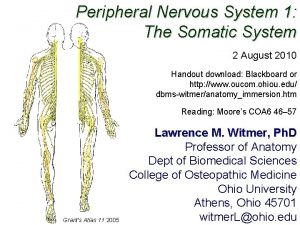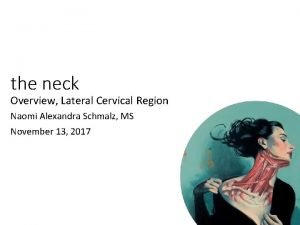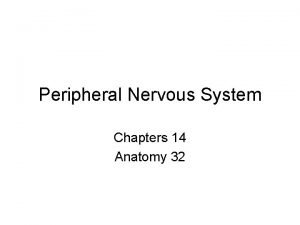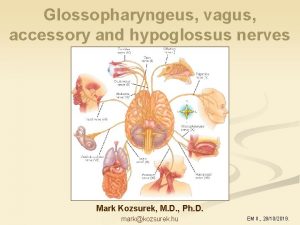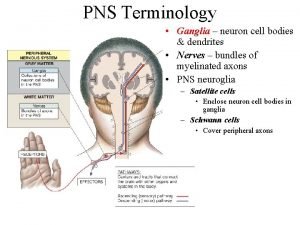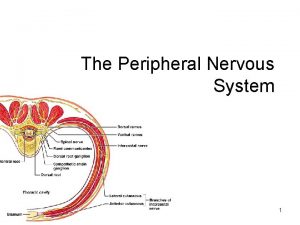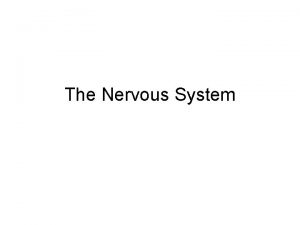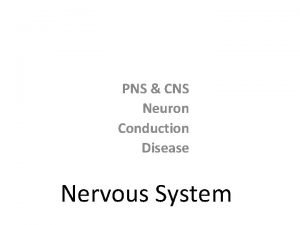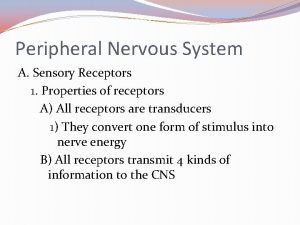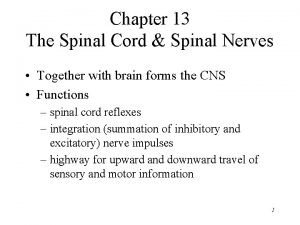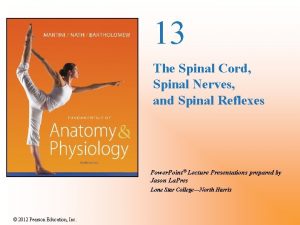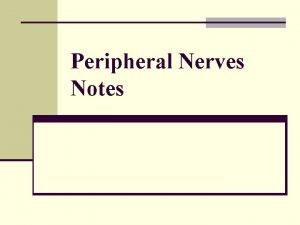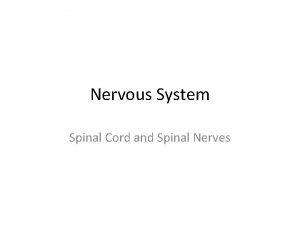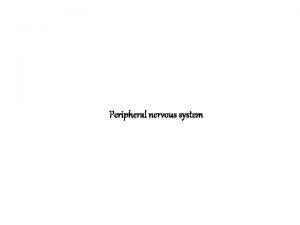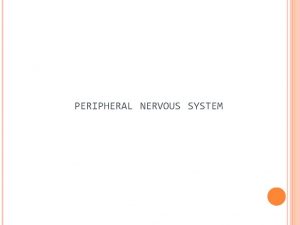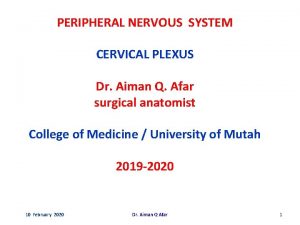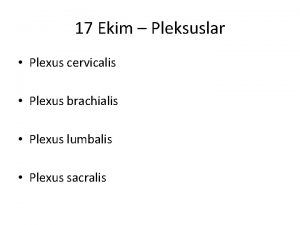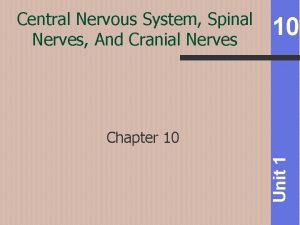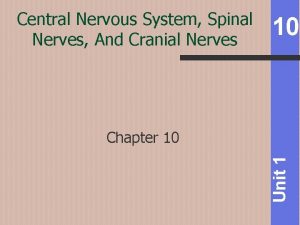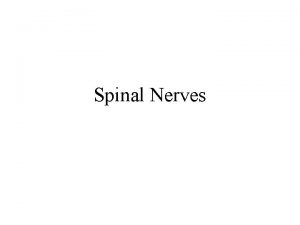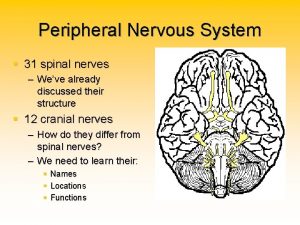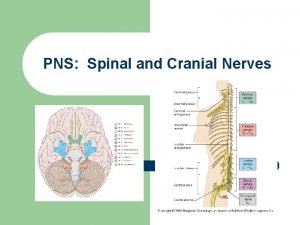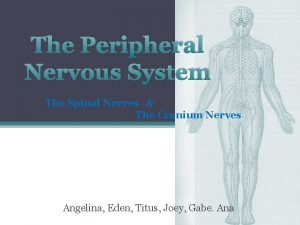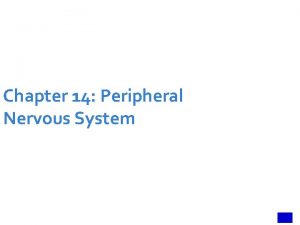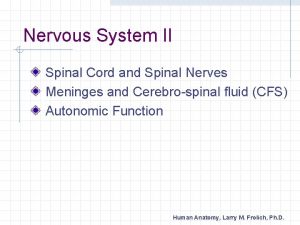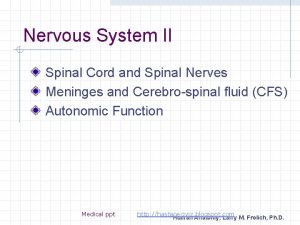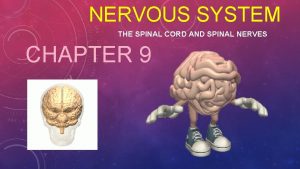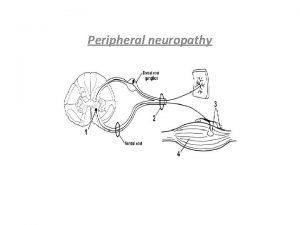Spinal nerves cervical plexus 1 Peripheral Nervous System

































- Slides: 33

Spinal nerves, cervical plexus 1

Peripheral Nervous System ways to categorize: § Motor or sensory § General (widespread) or specialized (local) § Somatic (outer tube) or visceral (inner tube) 2

____Cranial nerves attach to brain ___Spinal nerves attach to spinal cord 3

Peripheral sensory receptors By location: § Exteroceptors § Sensitive to stimuli arising from outside body § Interoceptors § Or visceroreceptors, from internal viscera § Proprioceptors § Monitor degree of stretch in skeletal muscles, tendons, joints and ligaments 4

Sensory Receptors § Free nerve endings (pain and temp) § Merkel discs (light touch) § Root hair plexuses – entwine hair follicles (light touch) § Encapsulated Meissner’s corpuscles (light touch in hairless skin) § Ruffini’s corpusucles (deep pressure and stretch) § Pacinian corpuscles (deep pressure, vibration, visceral: pain, nausea, hunger, fullness) 5

Proprioceptors § Skeletal muscles, joints, tendons, ligaments § Degree of stretch, therefore information on body movement: § to cerebrum, § cerebellum and § spinal reflex arcs § Include: -Muscle spindles -Golgi tendon organs -Joint kinesthetic receptors 6

Proprioceptors continued Muscle spindles: Intrafusal fibers – rate & degree of stretch Golgi tendon organs Near muscle-tendon junction: monitor tension within tendons Joint kinesthetic receptors Monitor stretch in synovial joints Send info to cerebellum and spinal reflex arcs 7

Peripheral motor endings § Innervation of skeletal muscle § Innervation of visceral muscles and glands 8

§ Motor axons innervate skeletal muscle fibers at neuromuscular junctions = motor end plates Resemble nerve synapses between neurons, except for acetylcholinesterase: breaks down acetylcholine so one twitch only 9

All muscles in motor unit contract together when neuron fires Stimulation of single motor unit causes weak contraction of entire muscle (spread out) Those with fine control – fewer fibers per motor neuron (avg. 150: range is 4 -100 s) Motor unit: motor neuron & all the muscle fibers it innervates 10

Innervation of visceral muscles & glands § Near end organ visceral motor axon swells = presynaptic terminals (vesicles with neurotransmitters): action slow (NT diffuses) 11

Spinal nerves § Part of the peripheral nervous system § 31 pairs attach through dorsal and ventral nerve roots § Lie in intervertebral foramina 12

§ Spinal cord segments are superior to where their corresponding spinal nerves emerge through intervetebral foramina § Spinal nerves are named according to the spinal cord segment from which they originate § § § 8 cervical 12 thoracic 5 lumbar 5 sacral 1 coccygeal § Cauda equina (“horse’s tail”): collection of nerve roots at inferior end of vertebral canal 13 http: //www. apparelyzed. com/spinalcord. html

Spinal nerves Dorsal roots – sensory fibers arising from cell bodies in dorsal root ganglia Ventral roots – motor fibers arising from anterior gray column of spinal cord 14

Spinal nerves § Note: cervical spinal nerves exit from above the respective vertebra § Spinal nerve root 1 from above C 1 § Spinal nerve root 2 from between C 1 and C 2, etc. § The remaining spinal nerve pairs emerge from the spinal cord below the same-numbered vertebra § Clinically, for example when referring to disc impingement, both levels of vertebra mentioned, e. g. C 6 -7 disc impinging on root 7 § Symptoms usually indicate which level 15

Spinal nerves § Dorsal roots – sensory fibers arising from cell bodies in dorsal root ganglia § Ventral roots – motor fibers arising from anterior gray column of spinal cord (not labeled on drawing) 16

§ Dorsal and ventral roots join in an intervertebral foramen forming spinal nerve § Outside foramen, re-branch as rami (sing. , ramus): Dorsal and ventral rami (somatic) Rami communicantes (visceral) 17

§ Dorsal rami serve the muscles and skin of the posterior trunk § Back, from neck to sacrum, innervated in a neatly segmented pattern: horizontal strip at same level as emergence from spinal cord § Ventral rami serve the muscles and skin of the lateral and anterior trunk § In thorax only, a simple segmented pattern as intercostal nerves § Also serve the limbs 18

Cross section of thorax showing main roots and branches of a spinal nerve § Note dorsal and ventral roots and rami, and rami communicantes § In the thorax, each ventral ramus continues as an intercostal nerve 19

Nerve plexuses § Networks of successive ventral rami that exchange fibers (crisscross & redistribute) § Why would this be protective? § Mainly innervate the limbs § Thoracic ventral rami do not form nerve plexuses 20

Plexuses § § Cervical Brachial Lumbar Sacral 21

Nerve plexuses § Cervical plexus (C 1 -C 4) innervates the muscles and skin of the neck and shoulder most important: Its phrenic nerve* (C 3 -C 5) is the sole motor supply of diaphragm: one reason why * neck injuries are so dangerous – can be lethal (respiratory arrest = stop breathing) 22

23

§ Serves upper limbs and shoulder girdle § Arises primarily from C 5 -T 1 § Main nerves (be able to label): Brachial plexus § Musculocutaneous – to arm flexors § Median – anterior forearm muscles and lateral palm § Ulnar – anteromedial muscles of forearm and medial hand § Axillary – to deltoid and teres minor § Radial – to posterior part of limb 24

25

26

27

28

Musculocutaneous Median Ulnar Axillary Radial 29

Brachial plexus 30

Note distribution of cutaneous nerves 31

Sensory innervation, palm 1. Ulnar nerve 2. Median nerve 3. Radial nerve 32

Dermatomes (innervation of skin) (area of skin innervated by the cutaneous branches from a single spinal nerve is called a dermatome) Reveal sites of damage to spinal nerves or spinal cord 33
 Central nervous system
Central nervous system Spinal cord
Spinal cord Spinal cord anatomy
Spinal cord anatomy Inferior gluteal nerve
Inferior gluteal nerve Spinal nerves
Spinal nerves Dermatome map
Dermatome map Plexus cervicalis
Plexus cervicalis Nervous system parts
Nervous system parts Cervical lymph nodes
Cervical lymph nodes Babinski reflex
Babinski reflex Cervical and brachial plexus
Cervical and brachial plexus Referred pain
Referred pain Neural circuits the organization of neuronal pools
Neural circuits the organization of neuronal pools Nervous
Nervous Nerve cell processes
Nerve cell processes Motor hierarchy
Motor hierarchy Art-labeling activity: main nerves of the brachial plexus
Art-labeling activity: main nerves of the brachial plexus Pirogovs triangle
Pirogovs triangle Medunerve
Medunerve Nervous system major divisions
Nervous system major divisions Saphenous nerve plexus
Saphenous nerve plexus Peripheral nervous system
Peripheral nervous system Central and peripheral nervous system
Central and peripheral nervous system Peripheral nervous system consists of
Peripheral nervous system consists of Peripheral nervous system consists of
Peripheral nervous system consists of Peripheral nervous system
Peripheral nervous system Peripheral nervous system
Peripheral nervous system Pns
Pns Peripheral nervous system
Peripheral nervous system Migranal
Migranal Visceral nervous system
Visceral nervous system 31 spinal nerves
31 spinal nerves Figure 13-1 the spinal cord
Figure 13-1 the spinal cord Neural circuits the organization of neuronal pools
Neural circuits the organization of neuronal pools





